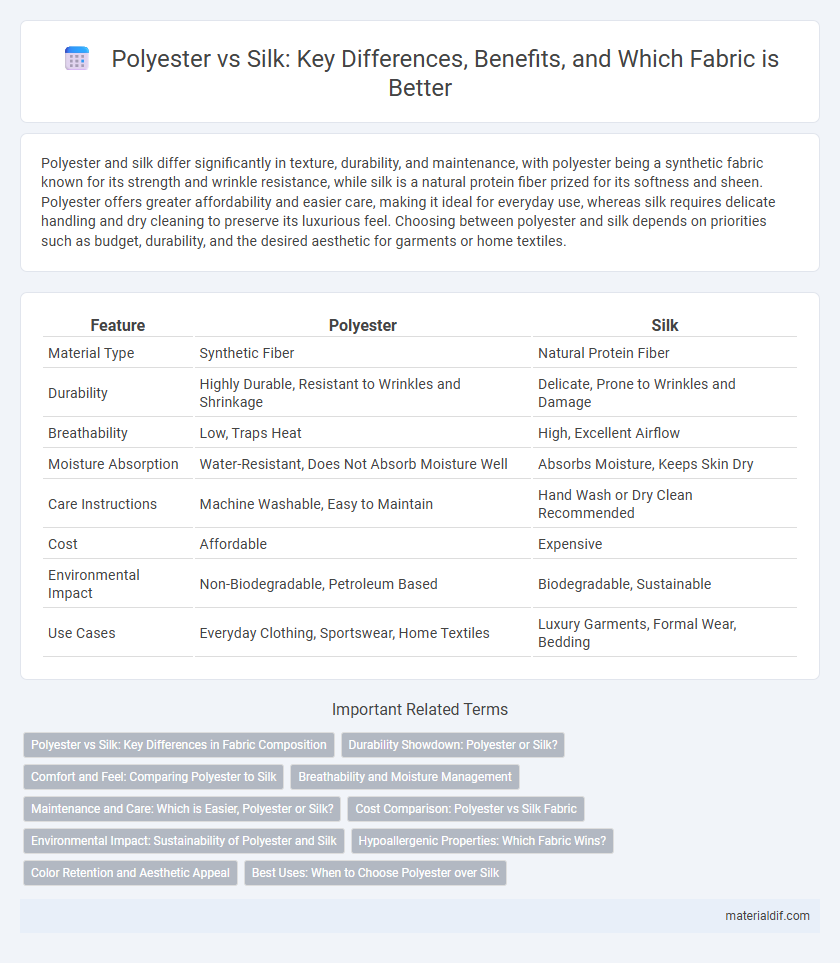Polyester and silk differ significantly in texture, durability, and maintenance, with polyester being a synthetic fabric known for its strength and wrinkle resistance, while silk is a natural protein fiber prized for its softness and sheen. Polyester offers greater affordability and easier care, making it ideal for everyday use, whereas silk requires delicate handling and dry cleaning to preserve its luxurious feel. Choosing between polyester and silk depends on priorities such as budget, durability, and the desired aesthetic for garments or home textiles.
Table of Comparison
| Feature | Polyester | Silk |
|---|---|---|
| Material Type | Synthetic Fiber | Natural Protein Fiber |
| Durability | Highly Durable, Resistant to Wrinkles and Shrinkage | Delicate, Prone to Wrinkles and Damage |
| Breathability | Low, Traps Heat | High, Excellent Airflow |
| Moisture Absorption | Water-Resistant, Does Not Absorb Moisture Well | Absorbs Moisture, Keeps Skin Dry |
| Care Instructions | Machine Washable, Easy to Maintain | Hand Wash or Dry Clean Recommended |
| Cost | Affordable | Expensive |
| Environmental Impact | Non-Biodegradable, Petroleum Based | Biodegradable, Sustainable |
| Use Cases | Everyday Clothing, Sportswear, Home Textiles | Luxury Garments, Formal Wear, Bedding |
Polyester vs Silk: Key Differences in Fabric Composition
Polyester is a synthetic fiber made from petroleum-based polymers, offering durability, wrinkle resistance, and affordability, while silk is a natural protein fiber produced by silkworms, known for its smooth texture and luxurious feel. Polyester's polyester terephthalate (PET) structure provides moisture-wicking and quick-drying properties, whereas silk's fibroin protein composition allows for breathability and natural temperature regulation. The key differences in fabric composition influence their performance, maintenance, and environmental impact, with polyester being less biodegradable compared to the biodegradable nature of silk.
Durability Showdown: Polyester or Silk?
Polyester outperforms silk in durability, offering exceptional resistance to wrinkles, stretching, and abrasions, making it ideal for everyday wear and active lifestyles. Silk, while luxurious and soft, is more delicate, prone to tearing and damage from perspiration and sunlight exposure. The synthetic fibers in polyester contribute to its long-lasting strength, ensuring garments maintain their shape and appearance over time compared to the natural protein fibers in silk.
Comfort and Feel: Comparing Polyester to Silk
Polyester fibers are less breathable than silk, often causing a warmer, less comfortable feel against the skin during extended wear. Silk's natural protein structure allows for superior moisture-wicking and softness, providing a luxurious and smooth texture that polyester cannot replicate. While polyester may resist wrinkles and moisture better, silk excels in comfort and tactile experience, making it the preferred choice for sensitive or delicate skin.
Breathability and Moisture Management
Polyester offers lower breathability compared to silk, as its synthetic fibers trap heat and moisture, leading to less ventilation. Silk naturally excels in moisture management by wicking away sweat and allowing air circulation, keeping the wearer cool and dry. These properties make silk preferable for activities requiring high breathability, while polyester is often used for its durability and moisture-wicking finishes in athletic wear.
Maintenance and Care: Which is Easier, Polyester or Silk?
Polyester offers superior ease of maintenance compared to silk, as it is machine washable, wrinkle-resistant, and quick-drying, requiring minimal special care. Silk demands delicate handling, often necessitating dry cleaning or gentle hand washing to preserve its natural fibers and sheen, making it more susceptible to damage from harsh detergents or rough treatment. The durability and resilience of polyester fibers make it a practical choice for individuals seeking low-maintenance fabric options.
Cost Comparison: Polyester vs Silk Fabric
Polyester fabric typically costs significantly less than silk, making it a budget-friendly option for clothing and home textiles. Silk is a natural protein fiber produced by silkworms, often priced higher due to its labor-intensive harvesting and luxurious properties. The cost difference reflects polyester's synthetic manufacturing process versus silk's rarity and exquisite texture.
Environmental Impact: Sustainability of Polyester and Silk
Polyester, a synthetic fiber derived from petroleum, has a significant environmental footprint due to its non-biodegradability and dependence on fossil fuels, contributing to microplastic pollution and high energy consumption during production. Silk, a natural protein fiber produced by silkworms, offers biodegradability and renewable sourcing but involves resource-intensive sericulture practices, including water use and land requirements. Comparing the two, silk generally has a lower carbon footprint and better biodegradability, while polyester's synthetic nature challenges sustainability despite recent advances in recycling technologies.
Hypoallergenic Properties: Which Fabric Wins?
Polyester, a synthetic fiber, is generally considered hypoallergenic because it resists common allergens like dust mites and mold, making it suitable for sensitive skin. Silk, a natural protein fiber, is also hypoallergenic due to its smooth surface that reduces allergen accumulation and its resistance to dust mites. While both fabrics exhibit hypoallergenic properties, silk often wins for its natural ability to minimize allergic reactions, though polyester remains a durable, hypoallergenic alternative.
Color Retention and Aesthetic Appeal
Polyester excels in color retention due to its synthetic fibers that resist fading from sunlight and washing, maintaining vibrant hues longer than silk. Silk, a natural protein fiber, offers superior aesthetic appeal with a luxurious sheen and smooth texture but tends to fade and discolor more quickly under exposure to light and detergents. The choice between polyester and silk depends on the priority given to durability of color versus the richness of fabric appearance.
Best Uses: When to Choose Polyester over Silk
Polyester is ideal for activewear, outdoor gear, and everyday clothing due to its durability, wrinkle resistance, and moisture-wicking properties, making it superior to silk in high-performance or low-maintenance situations. Choose polyester for budget-friendly, easy-care garments that withstand frequent washing and retain color vibrancy, unlike delicate silk which requires special handling. Polyester's synthetic fibers provide better stretch and shape retention, perfect for sportswear and casual attire compared to silk's luxurious but fragile nature.
Polyester vs Silk Infographic

 materialdif.com
materialdif.com